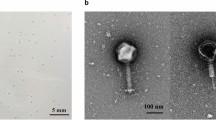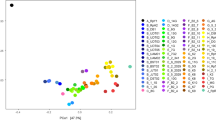Abstract
The GenBank database contains over 2580 complete genome sequences from bacteriophages. However, limited reports are available concerning phages can that lyse members of Pseudomonas syringae, although this is a widespread bacterial species that can infect almost 200 plant species. In the present study, we isolated and characterized a new Siphoviridae phage, named “Pseudomonas phage vB_PsyS_Phobos” (for brevity, referred to here as Phobos). To our knowledge, this is one of the first genome sequences reported for a phage with lytic activity against P. syringae pv. syringae. The genome of Phobos is dsDNA of 56,734 bp with a GC content of 63.3%, containing 65 ORFs. Genome analysis revealed that Phobos is a novel lytic phage with unique genomic features and low similarity to other phages, suggesting that Phobos represents a new phage genus. Genome sequencing did not reveal sequences with significant similarity to known virulence factors, antibiotic resistance genes, potential immunoreactive allergens, or lysogeny-related proteins, suggesting suggests that phage Phobos is strictly lytic. Therefore, Phobos may be suitable for formulation as a biocontrol agent against P. syringae pv. syringae.


Similar content being viewed by others
References
Buttimer C, McAuliffe O, Ross R, Hill C, O’Mahony J, Coffey A (2017) Bacteriophages and bacterial plant diseases. Front Microbiol 8:34
Mansfield J, Genin S, Magori S, Citovsky V, Sriariyanum M, Ronald P et al (2012) Top 10 plant pathogenic bacteria in molecular plant pathology. Mol Plant Pathol 13(6):614–629
Kering K, Kibii B, Wei H (2019) Biocontrol of phytobacteria with bacteriophage cocktails. Pest Manag Sci 75(7):1775–1781
Cui Z, Guo X, Dong K, Zhang Y, Li Q, Zhu Y, Zeng L, Tang R, Lib L (2017) Safety assessment of Staphylococcus phages of the family Myoviridae based on complete genome sequences. Sci Rep 7(1):41259
Adams MH (1956) Bacteriophages. Interscience publishers. Inc., New York
Green M, Sambrook J (2018) Isolation of high-molecular-weight DNA from suspension cultures of mammalian cells using proteinase K and phenol. Cold Spring Harb Protoc 4:93476
Besemer J, Borodovsky M (2005) GeneMark: web software for gene finding in prokaryotes, eukaryotes and viruses. Nucleic Acids Res 33:W451–W454
Finn R, Tate J, Mistry J et al (2007) The Pfam protein families database. Nucleic Acids Res 36:D281–D288
Philipson C, Voegtly L, Lueder M, Long KA, Rice GK, Frey KG et al (2018) Characterizing phage genomes for therapeutic applications. Viruses 10(4):188
Naville M, Ghuillot-Gaudeffroy A, Marchais A, Gautheret D (2011) ARNold: A web tool for the prediction of Rho-independent transcription terminators. RNA Biol 8(1):11–13
Lowe T, Chan P (2016) tRNAscan-SE On-line: integrating search and context for analysis of transfer RNA genes. Nucleic Acids Res 44(W1):W54–W57
Almpanis A, Swain M, Gatherer D, McEwan N (2018) Correlation between bacterial G+C content, genome size and the G+C content of associated plasmids and bacteriophages. Microb Genom 4(4):168
Dakheel K, Rahim R, Neela V, Al-Obaidi J, Hun T, Isa M, Yusoff K (2019) Genomic analyses of two novel biofilm-degrading methicillin-resistant Staphylococcus aureus phages. BMC Microbiol 19(1):114
Adriaenssens E, Brister J (2017) How to name and classify your phage: an informal guide. Viruses 9(4):70
Acknowledgements
Support for this research was provided by the CONACYT (Project no. 251516). The author appreciates the excellent technical assistance of Oscar Patrón and Luis Figueroa.
Author information
Authors and Affiliations
Corresponding author
Ethics declarations
Conflict of interest
The authors have declared that no competing interests exist.
Ethical approval
This article does not contain studies with human participants or animals performed by any of the authors.
Additional information
Handling Editor: T. K. Frey.
Publisher's Note
Springer Nature remains neutral with regard to jurisdictional claims in published maps and institutional affiliations.
Electronic supplementary material
Below is the link to the electronic supplementary material.
Rights and permissions
About this article
Cite this article
Amarillas, L., Estrada-Acosta, M., León-Chan, R.G. et al. Complete genome sequence of Phobos: a novel bacteriophage with unusual genomic features that infects Pseudomonas syringae. Arch Virol 165, 1485–1488 (2020). https://doi.org/10.1007/s00705-020-04618-2
Received:
Accepted:
Published:
Issue Date:
DOI: https://doi.org/10.1007/s00705-020-04618-2




